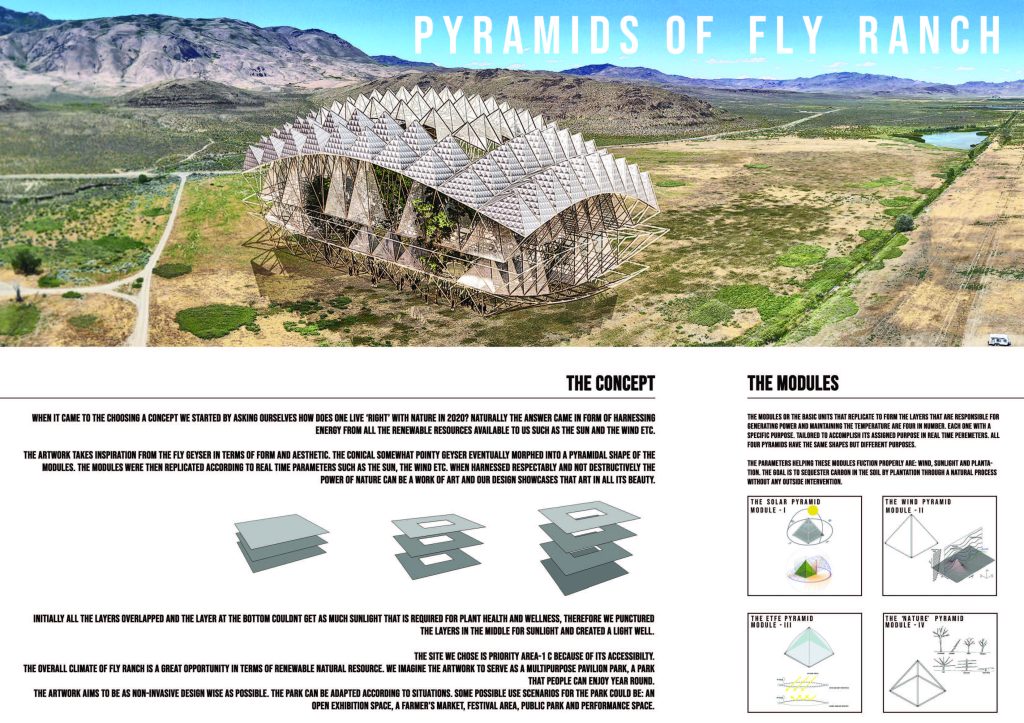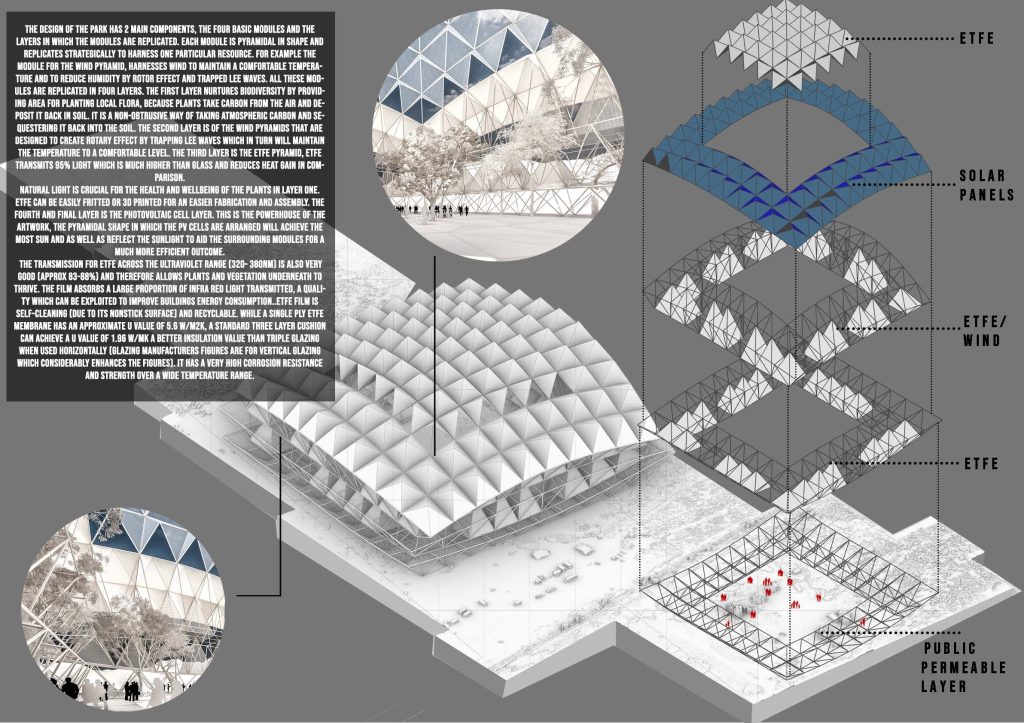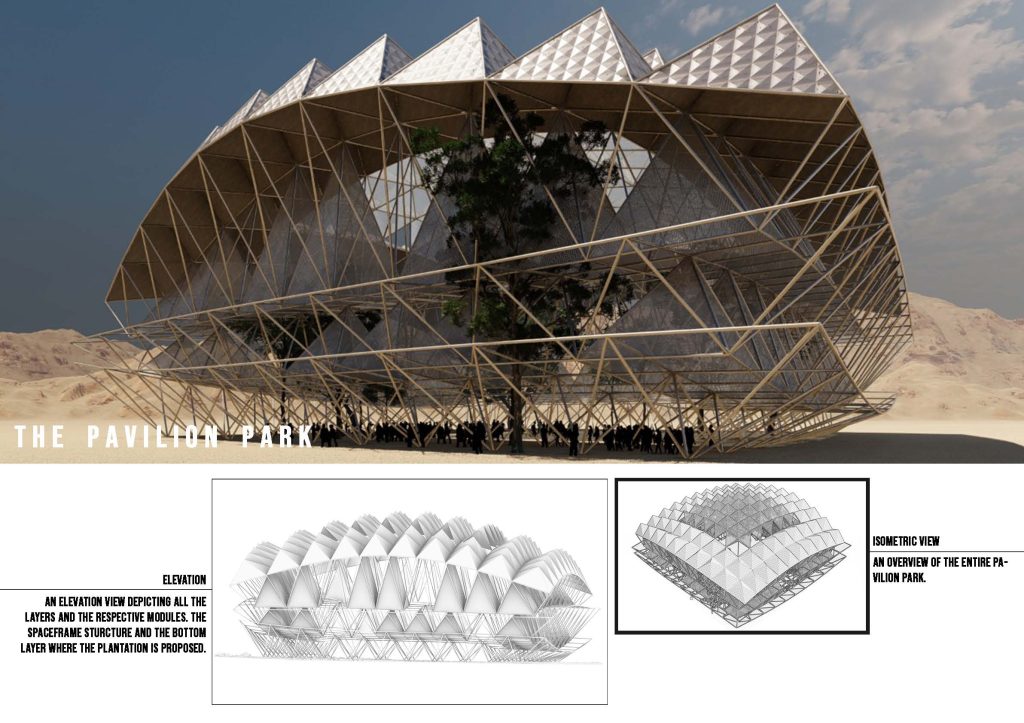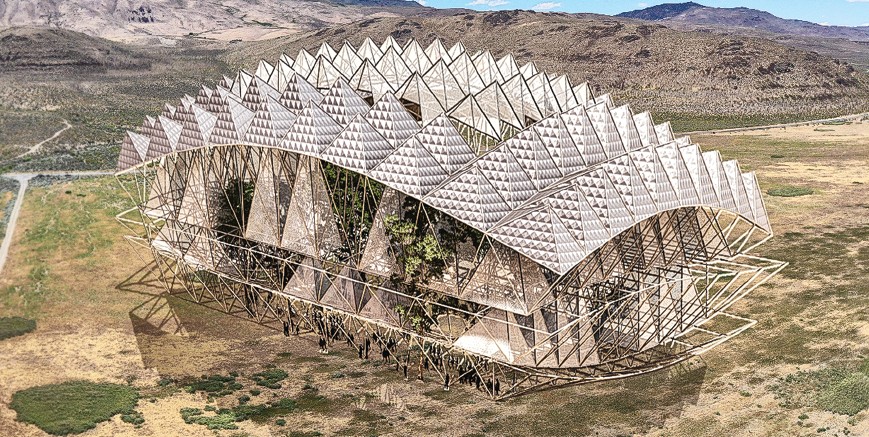Pyramids of Fly Ranch

Translation: This vast space doesn’t lack life, hundreds of canvases are there.
Poetry By Allama Muhammad Iqbal
Introduction:
When it came to the choosing a concept we started by asking ourselves how does one live right with nature in 2020? Naturally the answer came in form of harnessing energy from all the renewable resources available to us such as the sun and the wind etc.
The artwork takes inspiration from the Fly Geyser in terms of form and aesthetic. The conical somewhat pointy geyser eventually morphed into a pyramidal shape of the modules. The modules were then replicated according to real time parameters such as the sun, the wind etc. The overall climate of Fly ranch is a great opportunity in terms of renewable natural resource. We imagine the artwork to serve as a multipurpose pavilion park, a park that people can enjoy year round.
When harnessed respectably and not destructively the power of nature can be a work of art and our design showcases that art in all its beauty.
Our initial idea was to harness solar energy, which eventually lead to the pyramidal shapes of our modules. The aim was to not only harness solar energy but to maximize the energy acquired by necessary means. The pyramidal shape helps in optimizing the energy generated. Our concept evolved from the idea that centred on appreciating the un-conventional beauty that are life forms in a desert. Seeing the underappreciated.
Site & Possible Use:
Our intention was to make an artwork that didn’t intrude on nature but worked with it. The artwork is self-sufficient and goes beyond that by appreciating and nurturing local biodiversity. The artwork aims to be as non-invasive design wise as possible. The site we chose for this artwork is Priority Area 1-C. The artwork is design to be a multi-purpose park, which can be adapted according to situations. Some possible scenarios for the park could be: An Open Exhibition Space, A Farmer’s Market, Festival Area, Public Park and Performance Space.
Modules and Layers:
The design of the park has 2 main components, the four basic Modules and the Layers in which the modules are replicated. Each module is Pyramidal in shape and replicates strategically to harness one particular resource. For example the module for the Wind Pyramid, harnesses wind to maintain a comfortable temperature and to reduce humidity by rotor effect and trapped lee waves. All these modules are replicated in four layers. The first layer nurtures biodiversity by providing area for planting local flora, because plants take carbon from the air and deposit it back in soil. It is a non-obtrusive way of taking atmospheric carbon and sequestering it back into the soil. The second layer is of the wind pyramids that are designed to create rotary effect by trapping lee waves which in turn will maintain the temperature to a comfortable level. The third layer is the ETFE Pyramid, ETFE transmits 95% light which is much higher than glass and reduces heat gain in comparison. Natural light is crucial for the health and wellbeing of the plants in layer one. ETFE can be easily fritted or 3D printed for an easier fabrication and assembly. The fourth and final layer is the photovoltaic cell layer. This is the powerhouse of the artwork, the pyramidal shape in which the PV Cells are arranged will achieve the most sun and as well as reflect the sunlight to aid the surrounding modules for a much more efficient outcome.
Total Capacity of the Artwork:
- Surface PV Area of One Module: 450 sft à 40 Kwatt
- x 60% Efficiency Assumed Based On All four sides open and pyramid shape conformed with parametric shape à 24 KW(p)
- On site, Module 1 forms a pavilion of 200’-0” x 200’-0” is placed at PA-C1: 40000 sft 24k x 40000 = 1080 Mwatt
- Considering 100 % = 1080 Mwatt
* Only 50% PV is conventional PV, another 50% PV is ETFE for solar minimum/ heat trap inside the pavilion - Estimated cost per watt = 21,600 $
Annual Energy Expected:
Expected energy for one day in kWh:
450 sft (100% Conventional PV Panel Area) x 106 (Efficiency-absorption/day) x 0.75 (Effective Output % After Deducting Losses) = 35,775 kWh/day
For 30 modules of layer one: 35,775 x 30 = 1,073,250 approx.
With 50% effectiveness /day; 500,000 /day
Annual kWh = 500000 kwh/day x 365 = 182,500,000 kWh/year = 182500 mWh/year for 40000 sft pavilion




Leave a Reply